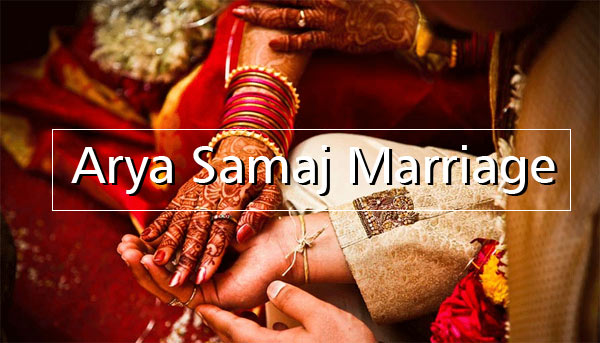Arya Samaj Marriage Ghaziabad India
Arya Samaj Marriage Ghaziabad India
Arya Samaj Marriage is one of the most simple and convenient way to get married. Hindus, Sikhs, Jains and Buddhists are eligible for Arya Samaj Marriage. Arya Samaj Marriage is very much similar to Hindu Marriage. Agni is considered as the sacred symbol and marriage is performed in presence of Agni. Arya Samaj was started by Swami Dayanad Saraswati in the year 1875. Arya Samajis do not believe in idol worhsip and believe in one God.
Arya Samaj Marriage does not requires heavy expenditure and just takes like traditional Indian Wedding and takes just a few hours to be completed. Arya Samaj Marriage is completely legal and does not requires any fixed wedding date as in arya samajis all dates are considered auspicious.
Eligibility Criteria For Arya Samaj Marriage
Marriage in an Arya Samaj Mandir can be performed only if the bride and groom fulfil the following eligibility criteria:
- The groom must be at least 21 years old and the bride must be 18 years old.
- The bride and groom must be Hindus, Buddhists, Jains or Sikhs.
- The bride or groom must not be Muslims, Christians, Parsis or Jews.
- Muslims, Christians, Paris and Jews can do arya samaj marriage after converting to Hinduism. This is also called as Shuddhi.
- The bride or groom must not have a living spouse at the time of the marriage.
Procedure for Arya Samaj Registration
- Make an appointment at the sub-divisional magistrate’s office. It takes at least 15 dyas. So it’s advisable to start this procedure before the marriage takes place.
- Fill the registration form.
- Submit all the proofs and documents needed.
- Two passport size photographs of the bride and the groom along with a photograph of the marriage. Bring the marriage invitation card (optional).
- Two witnesses who have to be physically present to sign.
- Attestation of gazetted officer is mandatory.
Consequently, after fulfilling all the formalities, the magistrate’s office will grant the marriage certificate, which is legally recognised by the court.
Documents required for solemnisation
- 4 copies of coloured photographs of both the bride and the groom.
- Proofs for the DOB and proofs for address by both the parties.
- The bride and the groom should have reached the eligibility.
- Two witnesses are acceptable to witness the wedding.
- In case if one of the spouse is a widow, then the widow has to submit the death certificate of the dead spouse.
- If one of the spouse is a foreign citizen or holding a foreign passport or is having foreign residential address, then the spouse requires the Certificate of present marital status of the party/ NOC from the concerned Embassy and Valid VISA.
Main rituals of Arya Samaj Marriage are:
- Madhuparka
- Kanyadan
- Havan
- Pani Grahan Sansakar
- Aashirwad
Madhuparka
The Priest / Panditji enchants the holy mantras at the arrival of bride and groom. This ritual is followed by exchange of garlands between the bride and groom. Mahduparka is a sacred mixture of five ingredients curd (dadhi), ghee (sarpis), water (jala), honey (kṣaudra) and white sugar (sitā). The bride offers the groom water three times, which the groom pours on his feet, sprinkles the drops of water on his body and drinks it the third time. After this the groom offers the water to bride and same process is followed by bride. Madhuparka is then offered to god and then the groom consumes it too.
Kanyadan
Kanyadan is the ritual in which the father of the bride hands over his daughter's hand the groom. This means that now it is the responsibility of groom to look after his wife.
Havan
Havan is the most important ritual. Fire is considered to be a sacred element and witness of marriage among hindus. The Pandit brings aling the Havan Samagri to perform the Havan.
Shilarohan
In this riutal the bride's mother places the bride's foot on a stone while the groom chants the mantras. This signifies that both the bride and groom will have strong foundation and solidarity in relationship and to stand with each other in all challnages of life.
Lajahom
The ritual that follows Shilarohan is Lajahom. This ritual consists of offering Murmura or puffed rice into the agni. Here, the bride and groom place their hand in hands and the brother of the bride pours puffed rice into them which is then offered into the holy fire.
Phere or Parikrama
The end of the bride's saree and groom's agnvastra are tied together by groom's sister. The groom and bride take four round around the sacred agni.
Saptapadi and Hriday Sparsh Mantra
After the phere, seven steps or ‘Saptapadi’ are taken by the couple followed by one circle around the fire. Here, the couple walk along side, hand in hand. The bride and groom also perform the Hriday Sparsh mantra ritual. Here the couple touch each other’s hearts and promise to be loyal to each other.
Sindoor and Mangalsutra
The final ritual is for the groom to apply sindoor on the rides forehead and also tie a mangalsutra around her neck. They feed each other sweets and promise to henceforth care and cherish each other. The arya samaj wedding ends with the couple where the newly-weds view the Dhruv or the Pole Star and then take blessings from the elders.
Finally the Arya Samaj Marriage can be registered under the Hindu Marriage Act by submitting the Arya Samaj Marriage Certificate at the concerned sub registrar's office.

